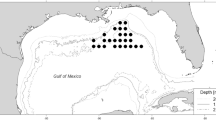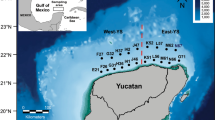Abstract
Parasitic nematodes have evolved to exploit a wide variety of hosts living in a range of marine environments. Benthimermithid nematodes occur deeper than any other nematode parasites (down to 5880 m depth) but are mostly known from free-living adult stages living in the sediments, and parasitic juveniles are seldom encountered. In the present study, the benthimermithid Trophomera cf. marionensis was discovered in the body cavity of the lysianassoid amphipod Hirondellea dubia sampled between 7018 and 10,005 m depths in the Kermadec Trench. The nematode specimens, which could be readily observed through the transparent exoskeleton of freshly caught amphipods, were up to twice the length of T. marionensis specimens described from the Atlantic and East Pacific Oceans but were otherwise morphologically identical. Because of its wide geographical and water depth distribution (almost 10,000 m), T. marionensis likely consists of several cryptic species. The prevalence of Trophomera parasites among the host population was estimated to be substantially less than 1 %; such a low proportion of parasitised hosts could help explain why so few Trophomera specimens have been obtained from their host so far. The present study demonstrates that parasites can occur throughout the entire ocean depth and that they likely occur in other hadal trenches where H. dubia and other lysianassoid amphipods also dominate.





Similar content being viewed by others
References
Belyaev GM (1972) Hadal bottom fauna of the world ocean. Zenkevich LA (ed.) Jerusalem: Israel Program for Scientific Translations.
Blankenship LE, Levin LA (2007) Extreme food webs: foraging strategies and diets of scavenging amphipods from the ocean’s deepest five kilometers. Limnol and Oceanog 52:1685–1697
Blankenship LE, Yayanos AA, Cadien DB, Levin LA (2006) Vertical zonation patterns of scavenging amphipods from the Hadal zone of the Tonga and Kermadec Trenches. Deep Sea Res I 53:48–61
Buron I, Morand S (2004) Deep-sea hydrothermal vent parasites: why do we not find more? Parasitology 128:1–6
Bussau C (1993) Taxonomische und ökologische untersuchungen an nematoden des Peru-Beckens. PhD thesis, University of Kiel, Germany
Campbell RA, Haedrich RL, Munroe TA (1980) Parasitism and ecological relationships among deep-sea benthic fishes. Marine Biol 57:301–313
Coomans A (1979) A proposal for a more precise terminology of the body regions in the nematode. Annales de la Societe Royale de Zoologie de Belgique 108:115–117
Jamieson AJ, Fujii T, Mayor DJ, Solan M, Priede IG (2010) Hadal trenches: the ecology of the deepest places on Earth. Trends Ecol Evol 25:190–197
Justine J, Cassone J, Petter A (2002) Moravecnema segonzaci n. sp., n. gen. (Nematoda:Cystidicolidae) from Pachycara thermophilum (Zoarcidae), a deep-sea hydrothermal vent fish from the Mid-Atlatic Ridge. Folia Parasitol 49:299–303
Leduc D (2015) One new genus and five new nematode species (Mohysterida, Xyalidae) from Tonga and Kermadec Trenches, Southwest Pacific. Zootaxa 3964:501–525
Miljutin DM (2004) New findings of deep-sea nematodes of genus Benthimermis Petter, 1980 (Nematoda, Benthimermithidae) with description of seven new species. Zoosystema 26:21–48
Miljutin DM (2006) The genus Trophomera Rubstov & Platonova, 1974 with description of T. litoralis sp. n. (Nematoda: Benthimermithidae) from the tidal zone of the Kuril Archipelago and proposal of Benthimermis Petter, 1980 as a junior synonym. Nematology 8:411–423
Miljutin DM (2011) Deep-sea parasitic nematodes of the genus Trophomera Robstov & Platonova, 1974 (Benthimermithidae) from the Equatorial Atlantic, with the descriptions of the two new species. Helgoland Marine Res 65:245–256
Miljutin DM (2014) Order Benthimermithida Tchesunov, 1995. In: Shmidt-Rhaesa A (ed) Handbook of Zoology Gastrotricha, Cyclioneura and Gnathifera, vol 2, Nematoda. De Gruyter, Hamburg, pp 179–186
Miljutin DM, Miljutina MA (2009) Description of Bathynema nodinauti gen. n., sp., n. and four new Trophomera species (Nematoda: Benthimermithidae) from the Clarion-Clipperton Fracture Zone (Eastern Tropic Pacific), supplemented with the keys to genera and species. Zootaxa 2096:173–196
Ritchie H, Jamieson AJ, Piertney SB (2015) Phylogenetic relationships among hadal amphipods of the Superfamily Lysianassoidea: Implications for taxonomy and biogeography. Deep-Sea Res I Oceanogr Res Pap 105:119–131
Somerfield PJ, Warwick RM (1996) Meiofauna in marine pollution monitoring programmes: a laboratory manual. Ministry of Agriculture, Fisheries and Food, Lowestoft, pp 71
Tchesunov AV (1988) New finds of deep-sea nematodes of the family Benthimermithidae in the South Atlantic with description of a new species. Vestnik Zoologii 5:12–22, In Russian
Tchesunov AV, Rozenberg AA (2011) Data on the life cycle of parasitic benthimermithid nematodes with the description of a new species discovered in marine aquaria. Russian J Nematol 19:139–150
Acknowledgments
Funding was provided by NIWA’s Coasts and Oceans Centre Research Programme ‘Marine Biological Resources’ and the project ‘Impact of resource use on vulnerable deep-sea communities’ (CO1X0906). We are grateful to Tim Shank (WHOI), Alan Jamieson (University of Aberdeen), Ashley Rowden and Malcolm Clark (both NIWA), principal investigators of the HADES project (HADal Ecosystem Studies, funded by the National Science Foundation, NSF-OCE 1130712, 1130494 and 1131620) and to the officers, crew and scientific personnel of RV Thomas G. Thompson (voyage TN309) and ROV Nereus engineers and technicians. We thank an anonymous reviewer for providing constructive criticisms on the manuscript.
Author information
Authors and Affiliations
Corresponding author
Rights and permissions
About this article
Cite this article
Leduc, D., Wilson, J. Benthimermithid nematode parasites of the amphipod Hirondellea dubia in the Kermadec Trench. Parasitol Res 115, 1675–1682 (2016). https://doi.org/10.1007/s00436-016-4907-7
Received:
Accepted:
Published:
Issue Date:
DOI: https://doi.org/10.1007/s00436-016-4907-7




